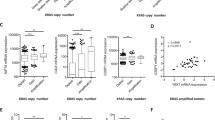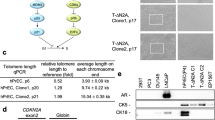Abstract
Using standard culture conditions, primary human mammary epithelial cells (HMECs) undergo a premature, transient growth arrest termed M0 (mortality stage 0) after 10–15 population doublings in vitro. It has been reported that emergence from this growth arrest by the abrogation of p16INK4a, a cyclin-dependent kinase inhibitor, and expression of the catalytic component of human telomerase (hTERT) are necessary for HMEC immortalization. Here we show that primary HMECs, grown on feeder layers, do not undergo this growth arrest and can be immortalized without abrogating p16. These findings support the concept that the so-called M0 stage represents a cell culture stress-induced growth arrest and that hTERT is sufficient to immortalize HMECs when cultured under adequate conditions.
This is a preview of subscription content, access via your institution
Access options
Subscribe to this journal
Receive 50 print issues and online access
$259.00 per year
only $5.18 per issue
Buy this article
- Purchase on Springer Link
- Instant access to full article PDF
Prices may be subject to local taxes which are calculated during checkout




Similar content being viewed by others
References
Brenner AJ, Stampfer MR, Aldaz CM . 1998 Oncogene 17: 199–205
DiRenzo J, Signoretti S, Nakamura N, Rivera-Gonzalez R, Sellers W, Loda M, Brown M . 2002 Cancer Res. 62: 89–98
Ethier SP, Mahacek ML, Gullick WJ, Frank TS, Weber BL . 1993 Cancer Res. 53: 627–635
Huschtscha LI, Noble JR, Neumann AA, Moy EL, Barry P, Melki JR, Clark SJ, Reddel RR . 1998 Cancer Res. 58: 3508–3512
Kiyono T, Foster SA, Koop JI, McDougall JK, Galloway DA, Klingelhutz AJ . 1998 Nature 396: 84–88
Morales CP, Holt SE, Ouellette M, Kaur KJ, Yan Y, Wilson KS, White MA, Wright WE, Shay JW . 1999 Nature Gen. 21: 115–118
Ouellette MM, Aisner DL, Saver-Train I, Wright WE, Shay JW . 1999 Biochem. Biophys. Res. Commun. 254: 795–803
Piatyszek MA, Kim NW, Weinrich SL, Hiyama K, Hiyama E, Wright WE, Shay JW . 1995 Methods Cell Sci. 17: 1–15
Ramirez RD, Morales CP, Herbert B-S, Rohde JM, Passons C, Shay JW, Wright WE . 2001 Genes Dev. 15: 398–403
Robles SJ, Adami GR . 1998 Oncogene 16: 1113–1123
Romanov SR, Kozakiewicz BK, Holst CR, Stampfer MR, Haupt LM, Tlsty TD . 2001 Nature 409: 633–637
Serrano M, Lin AW, McCurrach ME, Beach D, Lowe SW . 1997 Cell 88: 593–602
Shay JW, Wright WE . 2002 Nature Biotech. July, 2002 20: 682–688
Wright WE, Shay JW, Piatyszek MA . 1995 Nucleic Acids Res. 23: 3794–3795
Acknowledgements
We thank Y Zou for cytogenetics assistance and C Passons and D LaRue for technical assistance. This work was supported by a fellowship from the USAMR DAMD Breast Cancer Research Program to B Herbert, a grant from the NCI, CADRG, DCP, under CN-05017-63, and the Ellison Medical Foundation. WE Wright and JW Shay are co-holders of the Southland Financial Corporation Distinguished Chair in Geriatric Research.
Author information
Authors and Affiliations
Corresponding author
Rights and permissions
About this article
Cite this article
Herbert, BS., Wright, W. & Shay, J. p16INK4a inactivation is not required to immortalize human mammary epithelial cells. Oncogene 21, 7897–7900 (2002). https://doi.org/10.1038/sj.onc.1205902
Received:
Revised:
Accepted:
Published:
Issue Date:
DOI: https://doi.org/10.1038/sj.onc.1205902
Keywords
This article is cited by
-
Development and validation of immortalized bovine mammary epithelial cell line as an in vitro model for the study of mammary gland functions
Cytotechnology (2018)
-
Immortalization of pig fibroblast cells by transposon-mediated ectopic expression of porcine telomerase reverse transcriptase
Cytotechnology (2016)
-
p38α limits the contribution of MAP17 to cancer progression in breast tumors
Oncogene (2012)
-
Cancer-associated alteration of pericentromeric heterochromatin may contribute to chromosome instability
Oncogene (2012)
-
Human mammary cancer progression model recapitulates methylation events associated with breast premalignancy
Breast Cancer Research (2009)



